- How the washing machine works
- Washing machine does not turn on
- The machine draws water, but the wash process does not start
- Doesn't draw water or it draws slowly
- Stops just in the middle of the wash process
- It turns off in the "spin" mode or does not properly squeeze the laundry
- The drum is not spinning
- Washer door jammed
- Noise and rattling during operation
- Water flows from the machine
- The water is not heated
- The water does not drain at all
- Washing machine jumps and vibrates violently
- How to prevent breakage
The washing machine is no longer a luxury item for modern housewives. Today this "workhorse" is installed in almost every, even the most modest home. But no matter how modern and wonderful household appliances may seem, they still tend to break. The easiest way in such a situation, of course, is to invite a specialist who will quickly fix the malfunction. True, it will not be cheap.
But you can do it differently. It is not so difficult to repair a washing machine yourself. You don't need to have any special skills for this. You just need to carefully understand the structure of the washing machine and understand the principle of its operation. Therefore, if your washing machine breaks down, then, after carefully reading this article, you can fix at least half of the unpleasant situations with your own hands. So let's get started.
How the washing machine works
All household washing units not only have a similar device, but work on the same principle.
- After turning on the machine, loading the laundry and selecting the program, the door lock mechanism is activated and the machine starts working.
- Through the inlet valve, water enters the drum of the washing machine, the level of which is regulated by a special sensor.
- After the required amount of liquid has entered the drum, the valve closes.
- Now the water is heated to the desired temperature, the heating element turns on. Heating is also controlled by a special sensor, and if it is not there, a timer is triggered.
- Simultaneously with the thermal electric heater, the engine is turned on and the drum begins to slowly turn in different directions with an unequal time interval. This is to keep the laundry evenly wet.
- When the water is heated to the desired temperature, the heating element is turned off and the washing process begins. The drum rotates alternately in different directions with the same time interval. This mode is needed so that the laundry does not get confused.
- At the end of the process, the dirty water is pumped out using a pump and new water is drawn for rinsing.
- The drum starts rotating again at low speed, the laundry is rinsed.Depending on the selected mode, the rinsing process can be repeated several times.
- At the end of the last rinse, the pump starts up again. It pumps out water, after which the drum starts to rotate again, but at high speeds.
- This is the spinning process. In this case, the pump remains on all the time until the end of the wash.
![]() See also - How to check and repair a washing machine motor
See also - How to check and repair a washing machine motor
That's all. As you can see, there is nothing complicated about it. To understand why the washing machine broke down, you first need to know exactly when it happened, that is, to correctly determine the node that is working at the moment. Since the principle of operation of all units is the same, the main malfunctions of washing machines of any brand are also very similar. In this article we will try to disassemble them all, well, maybe, with the exception of some very small ones.
Washing machine does not turn on
If the washing machine does not show signs of life at all, the reason can be ridiculously trivial - it was simply forgotten to plug it in.
Also, the machine will not work if the door is open or not closed properly. Typically, this is signaled by the electronics and the corresponding icon is displayed on the display. The wrong wash program is also one of the common reasons.
If all of the above reasons are excluded, and the washing machine still does not work, the matter may be that the electrical part is out of order. First of all, check the machines on the dashboard, they are probably knocked out by overload.
Everything is good? Check the outlet to see if it's burnt out? Now inspect the plug, unscrew it and make sure that the contacts are not oxidized and are in working order.
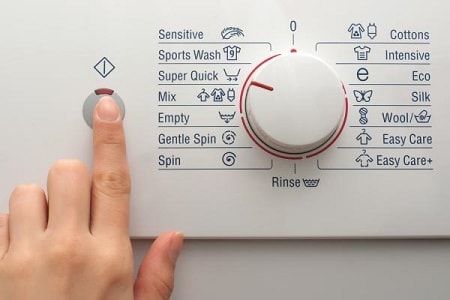
And everything is fine here? We move further along the wire. You will need to remove the outer panels to check the terminal connections and ring the power cord. Just be sure to unplug the plug before doing this.
If your automatic machine has a mechanical timer, it may be the cause of the breakdown. Turn the knob until you hear the drum spinning. If it works, then the unit is most likely burned out and will have to be replaced.
Another reason why the washing machine does not turn on, there may be a closed intake valve. Make sure it is in the “open” position and that water enters the drum.
The machine draws water, but the wash process does not start
There may also be several reasons for this:
- Heating element burned out. If this happens, the sequence of processes is lost and the washing does not start. The assembly needs to be replaced.
- The belt drive has broken. We'll have to completely disassemble the machine to see this.
- The water level or temperature sensors are out of order.
- Burnt out processor. The washing machine does not receive any commands and does not understand what it needs to do.
- Inlet valve defective. It may not open well or close tightly as a result of a blockage. It is necessary to remove the blockage, and so that the situation does not recur again, install an additional filter at the inlet.
- The most unpleasant and expensive reason to repair is a burned out electric motor. It will definitely not be possible to eliminate such a breakdown on your own, of course, if you do not know how to rewind electric motors.
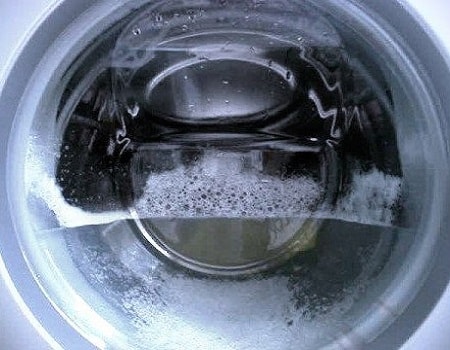
Doesn't draw water or it draws slowly
If a the washing machine does not draw water or does it very badly, there may be several reasons for this:
- the supply valve is closed;
- the inlet hose is clogged or deformed; you need to straighten it and clear the blockage;
- the intake filter is coked; to clean it, turn off the water, disconnect the hose from the machine, remove the filter and rinse it under a strong stream of water, and then perform all the steps in the reverse order;
- the intake valve is clogged and out of order; you need to turn off the water and replace it;
- the water level regulator is out of order; when the water level in the drum rises, the displaced air presses on the pressure regulator and the switch is activated; if the system is clogged or damaged, no water will be drawn.
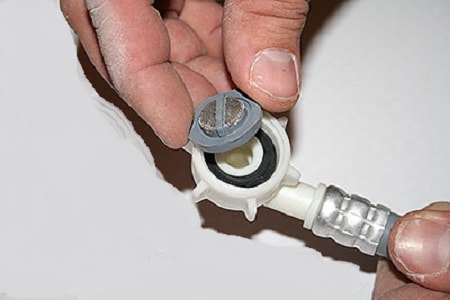
Another reason why water is drawn into the machine very slowly or does not flow at all may be associated with low pressure in the system. This is not a breakdown and you will not be able to fix it yourself. As soon as the pressure in the system returns to normal, everything will correct itself. If this situation repeats regularly, then to eliminate it, you need to raise the pressure in the system. For example, equip a pressure tank in the attic of a private house or under the ceiling of an apartment.
Stops just in the middle of the wash process
If a the washing machine stops during washing and did not complete it, there may be several reasons:
- Blockage in the system. Forcibly drain the water and clean the inlet and outlet hoses and all possible filters.
- The electricity supply has been cut off. Check the plugs and vending machines on the dashboard, smell the outlet, check if there is a light in another part of the house, ring all contacts.
- Wrong mode selection. Perhaps there is a pause in the program you have selected and you just need to wait.
- The pump is broken, water is not pumped out at the right time and the washing process is disrupted.
- The water pressure in the system has dropped. Check with what pressure water flows from any tap in your home. If the pressure is low, pause the wash, wait for the good flow to resume and continue.
- The thermostat or heating element has broken, the water does not heat up to the desired temperature, the program fails.
- Poisons the outlet hose, water constantly goes into the drain. At the same time, the system pumps water into the drum to the required level, the processor “thinks” all the time that the water has not yet collected. To eliminate the malfunction, you need to check the reliability of the connection of the outlet hose and the drain riser.
- The control timer has expired. The machine “does not understand” when it is necessary to complete one process and start another, and therefore stops completely. This is a rather complex device. Doing it yourself will not work, it's easier to buy and install a new one.
- Electric motor burned out. This breakdown is also very difficult to fix on your own, you will have to call the master.
It turns off in the "spin" mode or does not properly squeeze the laundry
Often the washing machine does not spin the laundry because the drain system is clogged. To remedy the situation, you need to clean the filter and remove hair, threads and various small objects that have entered the system.
If it does not help, then the pump may have burned out and the water from the tank is not pumped out.
When the water is drained off normally, and the spinning does not work, then the drive belt is worn out or stretched. To fix the problem, it must be tightened or replaced with a new one.
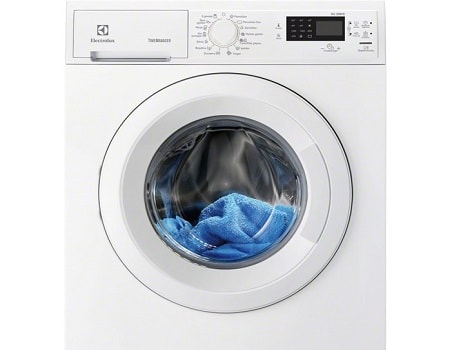
The drum is not spinning
To find the reason why the drum is not spinning in the washing machine need to:
- Check the selected mode, perhaps the wash program includes a pause.
- Inspect the drive belt. It probably jumped off or stretched out. Press on the belt to check the tension. Its offset should be approximately 12 mm. If the washing machine is equipped with a tensioner, loosen or tighten the belt to the correct level. In the case when such a design is not provided, the only way out of the situation is to replace the belt.
- Pull on the loading door. If the latch is broken or stuck and the door does not close properly, the drum will not work. Open the door and close it abruptly again, press firmly. If all else fails, the lock is broken and needs to be replaced.
- Ring the electric motor. It is likely that it burned out.
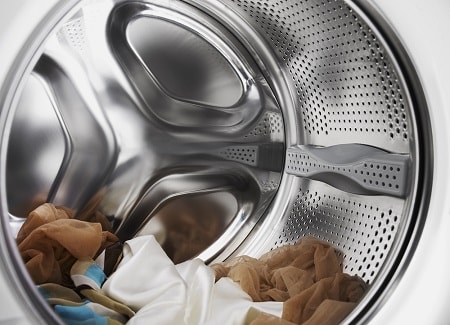
Washer door jammed
This malfunction can also be caused by several reasons.
- Opening delay. Maybe, the washing machine door does not openbecause the drum has not yet finished rotating and the washing program has not ended.One or two minutes after the end of the process, the lock will unscrew itself.
- There is water left in the tank. Many washing machines are programmed so that until the water is completely pumped out of the tank, the lock will not open. To open the door, it is necessary to drain the water forcibly and check if the drain filter is clogged. After that, everything should work out.
- The lock switch is broken and needs to be replaced.
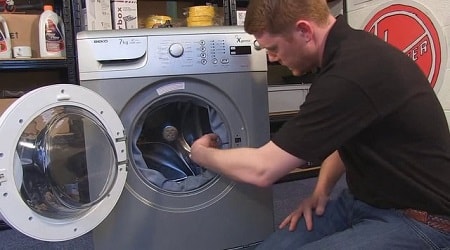
Noise and rattling during operation
Such a malfunction can be determined by the nature of the sound that the machine makes. If you hear uneven metallic ringing, banging, or rattling that stops when the drum stops, it is most likely that small metal objects have entered the machine. These can be coins, nuts, keys that fell out of pockets. (See also: Why does the washing machine make a lot of noise during spinning)
A buzzing sound that becomes quieter when the door is pressed hard indicates a broken latch. If not repaired in time, the door can jam at the most inopportune moment.
A screech during the rotation of the drum indicates slipping of the drive belt. Try to pull it on, everything should work out.
Crackling and knocking during drum operation indicates bearing wear. Have to replace the bearing in the washing machine. If this is not done, the shaft can be broken and the repair of the machine will be much more expensive.
Water flows from the machine
In order to determine exactly where and how much it flows, you need to do a simple operation. Wipe the floor dry and place a dry cloth under the machine. Run a short wash cycle without laundry or powder. Examine the rag carefully, you will see from which side you need to look for a leak.
The main the reasons for the leakage of the washing machine may be due to: cracks in the hoses, loosening of the clamps, distortion or rupture of the seal on the door, and so on. If all parts of the machine are intact, the reason may be that the sewer is clogged and the water simply has nowhere to go.
The water is not heated
First of all, you need to disassemble the machine and inspect the heater. It is likely that too much scale has formed on it or that it has burned out. In the first case, it is enough to clean the heater from limescale; in the second, the unit will have to be replaced. (See also: How to descale your washing machine)
If the machine does not heat the water, then the cause may be the water level controller. When the device is broken, the unit simply "does not understand" that there is enough water and it is time to turn on the heating element.
Another likely cause may be a broken thermal relay. It turns off the heating element even before the water heats up to the required temperature.
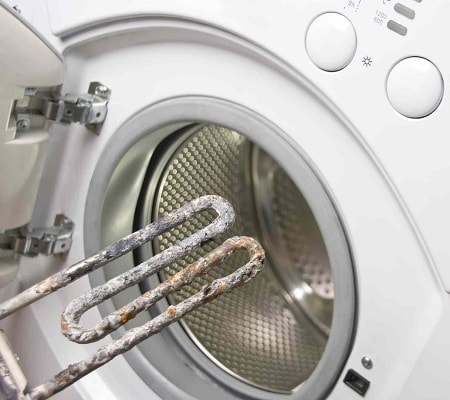
Water doesn't drain at all
The most harmless reason may be choosing the wrong wash mode. See if the switch is in rinse hold mode. It is also likely that the wash program has stopped due to a lack of electricity - check the plugs.
Another quickly removable reason that water does not leave the washer can be a clogged filter or drain pipe, as well as its bending. Check and clean these components and reconnect the machine.
Blockage or breakdown of the pump is another cause of the malfunction. Forcibly drain the water, disconnect the pump, clean it or replace it with a new one.
The next reason is why the washing machine does not drain the water it may be in the electrical part: any contacts have been oxidized, a timer or a water level switch has failed. All these areas need to “ring” and, if necessary, replace the damaged part.
The washing machine jumps and vibrates violently
The first reason that the washing machine suddenly starts walking around the apartment is a strong overload. Remove some of the items from the drum and follow the instructions in the future. If there are not very many things, they may have become entangled and strayed into a lump. Unravel the knot and load the machine more evenly.
If a the washing machine jumps or vibrates during the spin cycle even with a small number of things, the reason may be a broken spring holding the drum. When replacing the spring, carefully inspect the balances attached to the tank with bolts. Perhaps the fasteners are loose and the weights are loose. Correct the situation.
![]() See also - Replacing shock absorbers in a washing machine with your own hands
See also - Replacing shock absorbers in a washing machine with your own hands
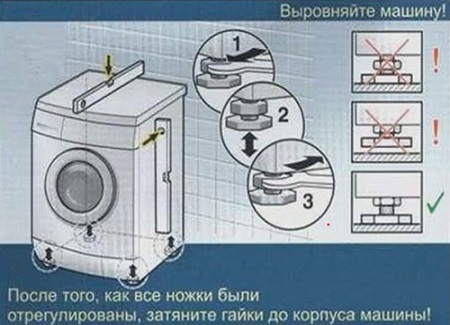
Also, the machine, which is not on the level, "starts to dance". Adjust the position of the washer using the feet. They have adjusting bolts. If they are not enough, just place a few sheets of thick cardboard in the right places.
Our partners, the RemonTechnik service center, are ready to assist in the repair of large household appliances of any complexity. Didn't do it yourself? Seek help from qualified craftsmen.
How to prevent breakage
As you can see, repairing washing machines is not so complicated. But is it possible to make the washing machine break as little as possible? It turns out you can. The most frequent breakdowns of washing machines are associated precisely with improper operation. In order for the unit to serve you as long as possible, you need to follow some simple rules:
- carefully read the instructions and strictly follow all its points;
- Do not overload the machine;
- use special detergents containing a water softener;
- once every three months, run the longest wash cycle without clothes, but with an anti-scale agent, this will help keep the heating elements in order;
- carefully check all pockets for small items and debris;
- regularly clean filters at the inlet and outlet of the system;
- install an additional cleaning filter, this will protect the system from dirt and debris;
- after each wash, leave the door ajar and wipe the rubber seal dry;
- purchase and install a stabilizer, it will help protect the electrical part of the machine from power surges.
See also:


We have a washing machine. Hansa AWN510DR.
About a month ago the problem started.
In any washing mode and even on spinning, the process ends and the water is drained.
Only the inscription END pops up, a three-way signal, drains and the door opens everything, no errors, such as, the door is open, etc. not.
The masters came to us: who suggested that there was something with the lock, but advised us to contact another, who also came to us, watched the car for about 3 hours, disassembled the lock and concluded that it is POSSIBLE, but not exactly the problem in the lock.
When washing with a high temperature, the water heats up stably. They released the drain hose into the bathroom, raised the level ... The problem did not disappear.
The castle, if you order, then wait a month at a price of about 2.5 thousand. And then, it is not known if the reason is in it
Maybe you have any thoughts?